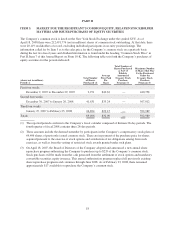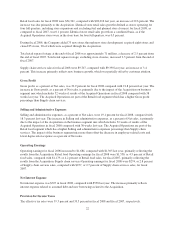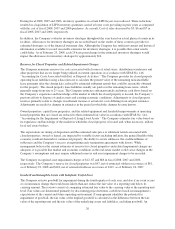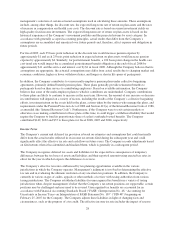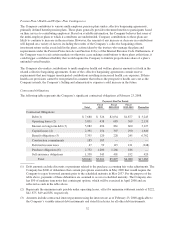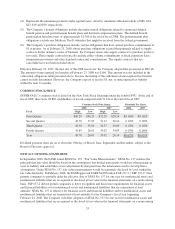Albertsons 2008 Annual Report Download - page 32
Download and view the complete annual report
Please find page 32 of the 2008 Albertsons annual report below. You can navigate through the pages in the report by either clicking on the pages listed below, or by using the keyword search tool below to find specific information within the annual report.During fiscal 2008, 2007 and 2006, inventory quantities in certain LIFO layers were reduced. These reductions
resulted in a liquidation of LIFO inventory quantities carried at lower costs prevailing in prior years as compared
with the cost of fiscal 2008, 2007 and 2006 purchases. As a result, Cost of sales decreased by $5, $6 and $7 in
fiscal 2008, 2007 and 2006, respectively.
In addition, the Company evaluates inventory shortages throughout the year based on actual physical counts in its
facilities. Allowances for inventory shortages are recorded based on the results of these counts to provide for
estimated shortages as of the financial statement date. Although the Company has sufficient current and historical
information available to record reasonable estimates for inventory shortages, it is possible that actual results
could differ. As of February 23, 2008, each 25 basis point change in the estimated inventory shortages would
impact the allowances for inventory shortages by approximately $14.
Reserves for Closed Properties and Related Impairment Charges
The Company maintains reserves for costs associated with closures of retail stores, distribution warehouses and
other properties that are no longer being utilized in current operations in accordance with SFAS No. 146,
“Accounting for Costs Associated with Exit or Disposal Activities.” The Company provides for closed property
operating lease liabilities using a discount rate to calculate the present value of the remaining noncancellable
lease payments after the closing date, reduced by estimated subtenant rentals that could be reasonably obtained
for the property. The closed property lease liabilities usually are paid over the remaining lease terms, which
generally range from one to 25 years. The Company estimates subtenant rentals and future cash flows based on
the Company’s experience and knowledge of the market in which the closed property is located, the Company’s
previous efforts to dispose of similar assets and existing economic conditions. Adjustments to closed property
reserves primarily relate to changes in subtenant income or actual exit costs differing from original estimates.
Adjustments are made for changes in estimates in the period in which the changes become known.
Owned properties, capital lease properties, and the related equipment and leasehold improvements at operating
leased properties that are closed are reduced to their estimated fair value in accordance with SFAS No. 144,
“Accounting for the Impairment or Disposal of Long-Lived Assets.” The Company estimates fair value based on
its experience and knowledge of the market in which the closed property is located and, when necessary, utilizes
local real estate brokers.
The expectations on timing of disposition and the estimated sales price or subtenant rentals associated with
closed properties, owned or leased, are impacted by variable factors including inflation, the general health of the
economy, resultant demand for commercial property, the ability to secure subleases, the creditworthiness of
sublessees and the Company’s success at negotiating early termination agreements with lessors. While
management believes the current estimates of reserves for closed properties and related impairment charges are
adequate, it is possible that market and economic conditions in the real estate market could cause changes in the
Company’s assumptions and may require additional reserves and asset impairment charges to be recorded.
The Company recognized asset impairment charges of $12, $7 and $66 in fiscal 2008, 2007 and 2006,
respectively. The Company’s reserve for closed properties was $97, net of estimated sublease recoveries of $81,
as of February 23, 2008 and $118, net of estimated sublease recoveries of $119, as of February 24, 2007.
Goodwill and Intangible Assets with Indefinite Useful Lives
The Company reviews goodwill for impairment during the fourth quarter of each year, and also if an event occurs
or circumstances change that would more-likely-than-not reduce the fair value of a reporting unit below its
carrying amount. The reviews consist of comparing estimated fair value to the carrying value at the reporting unit
level. Fair values are determined primarily by discounting projected future cash flows based on management’s
expectations of the current and future operating environment. If management identifies the potential for
impairment of goodwill, the fair value of the implied goodwill is calculated as the difference between the fair
value of the reporting unit and the fair value of the underlying assets and liabilities, excluding goodwill. An
26




